
Copyright 2019 by Linda Kohanov
Much information categorized as “spiritual” or “mystical” is nonverbal or unphotographable, not supernatural.
Linda Kohanov
The Power of the Herd
When the space shuttle Challenger exploded in 1984, NASA determined that a low-tech piece of rubber known as an “O ring” was the root cause. Similarly, in human interactions, our tendency to overlook the little things—all those seemingly inconsequential nonverbal cues, inconvenient feelings and unconscious reactions—lead to unexpected eruptions at work, home, school, and in larger social contexts.
Perhaps just as tragic, the “mechanisms” behind joy and fulfillment are also based on subtle physiological and psychological processes obscured by modern life’s frenetic pace. A growing addiction to technology causes us to treat our own bodies more like machines than sentient beings. In the process, we neglect to exercise the soulful “muscles” that promote peace, connection, and satisfaction.
In our extroverted, intensely competitive culture, the solution to this dilemma seems counterintuitive—and a bit odd, as it combines perspectives that at first glance seem both earthy and mystical.
But it’s not rocket science, though I have been known to teach it to rocket scientists.
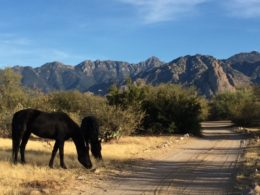 For over a decade, I’ve shared these leadership, social intelligence, and life enhancement skills with engineers at a major defense contractor, most effectively through non-riding, experiential activities with horses. Understandably, during our on-site orientation session, these intelligent, naturally skeptical people want me to explain why they have to leave the office and trek out to the desert for this training, especially when most have never touched a horse before, let alone interacted meaningfully with one.
For over a decade, I’ve shared these leadership, social intelligence, and life enhancement skills with engineers at a major defense contractor, most effectively through non-riding, experiential activities with horses. Understandably, during our on-site orientation session, these intelligent, naturally skeptical people want me to explain why they have to leave the office and trek out to the desert for this training, especially when most have never touched a horse before, let alone interacted meaningfully with one.
“Accessing the emotional intelligence and nonverbal communication skills involved in exceptional leadership is more art than science,” I tell them.  “But there is some intriguing science behind it. Psychologists in the 1990s determined that only about 10 percent of human communication is verbal. That means 90 percent of the messages we send back and forth to each other are in that nonverbal range. If you work with people, if you want to influence them, handle their resistance, and inspire them to collaborate at an optimal level, facility in working with the ‘other 90 percent’ can mean the difference between success, mediocrity, or even abject failure.”
“But there is some intriguing science behind it. Psychologists in the 1990s determined that only about 10 percent of human communication is verbal. That means 90 percent of the messages we send back and forth to each other are in that nonverbal range. If you work with people, if you want to influence them, handle their resistance, and inspire them to collaborate at an optimal level, facility in working with the ‘other 90 percent’ can mean the difference between success, mediocrity, or even abject failure.”
These clients make smart missiles. They have to get every small detail right or things blow up at the wrong time and place. Those promoted to managerial positions, however, are often more perplexed by the difficulties involved in wrangling groups of humans—even if the leaders, and their “followers” in this case, are, quite literally, geniuses. People, including those with high IQs and PhDs, are often harder to predict and direct than an arsenal of nuclear explosives.
 “Horses have their own kind of genius,” I explain. “They’re masters at exercising assertiveness, relationship, and mindfulness skills. As animals that can be preyed upon in nature, they’ve evolved to pay attention and respond to vast amounts sensory input that humans ignore. But it’s not all about reading the intentions of predators. Much of this information guides how herd members manage their relationships, including how they build trust, deal with aggressors, and negotiate power plays. Horses are among the most mindful creatures you’ll ever meet. They use their entire bodies as tuners, receivers and amplifiers for nonverbal information. The experienced teacher horses in my herd take it one giant step further: They’ve become experts at helping people learn how to not just access, but leverage that other 90 percent.”
“Horses have their own kind of genius,” I explain. “They’re masters at exercising assertiveness, relationship, and mindfulness skills. As animals that can be preyed upon in nature, they’ve evolved to pay attention and respond to vast amounts sensory input that humans ignore. But it’s not all about reading the intentions of predators. Much of this information guides how herd members manage their relationships, including how they build trust, deal with aggressors, and negotiate power plays. Horses are among the most mindful creatures you’ll ever meet. They use their entire bodies as tuners, receivers and amplifiers for nonverbal information. The experienced teacher horses in my herd take it one giant step further: They’ve become experts at helping people learn how to not just access, but leverage that other 90 percent.”
Conscious or Unconscious?
At this point in the discussion, most people nod thoughtfully or lean forward enthusiastically. Invariably, however, I also see a few staff members shift uncomfortably in their seats. At first, I thought fear of horses was the main concern, but that’s rarely the case, as it turns out. Over the years, I’ve learned that some people are much more nervous about the unexpected, possibly unwelcome things they might discover in this unfamiliar setting.
And something else: As one particularly insightful man put it during a training five years ago, “I’m not comfortable with the nonverbal communication aspect.”
“Can you tell me more about this?” I asked.
“I’m not into woo-woo stuff. And I most certainly don’t want to go unconscious.”
 I was taken aback by his last statement, intrigued by an important nuance I had never considered before. “Becoming conscious of the nonverbal is one of the main points of this training,” I said. “But I understand your concern. Most people disregard the ‘other 90 percent,’ which means it does remain unconscious. When nonverbal input is suppressed, simply because we habitually think in words, symbols, or mathematical formulas, we sometimes act out unconsciously and illogically because the pressure of all the information we ignore doesn’t go away. It builds up over time, breaks through our intellectual defenses, and causes us to react in impulsive, ineffective, sometimes downright embarrassing ways.
I was taken aback by his last statement, intrigued by an important nuance I had never considered before. “Becoming conscious of the nonverbal is one of the main points of this training,” I said. “But I understand your concern. Most people disregard the ‘other 90 percent,’ which means it does remain unconscious. When nonverbal input is suppressed, simply because we habitually think in words, symbols, or mathematical formulas, we sometimes act out unconsciously and illogically because the pressure of all the information we ignore doesn’t go away. It builds up over time, breaks through our intellectual defenses, and causes us to react in impulsive, ineffective, sometimes downright embarrassing ways.
“Interpersonal situations at work and at home can break down slowly, almost imperceptibly over time, then suddenly explode, like missiles that rupture unexpectedly due to some key factor overlooked along the way. Those who discount the nonverbal dimension of relationship are more likely to be mesmerized by words, dismissing a host of body language cues and other signals designed to alert us when people are conflicted, confused, frustrated, resistant, or even deceptive.
“Though we may never be as good as horses are at gathering and responding to nonverbal input, humans are fully capable of processing larger and larger amounts of this information as we too learn how to use our bodies as tuners, receivers and amplifiers for what the brain alone ignores. When you  pay attention to what lies beyond words, a whole new world of awareness opens up. Though, truly, it has been there all along. It’s similar to the invention of microscopes and telescopes. The universe of information we’re able to glimpse, then study, then use purposefully expands exponentially when we use this technology. It’s the same when you learn how to work your own somatic tuner, receiver and amplifier. Shifts in behavior, expression, and posture, as well as more subtle cues indicating the unspoken feelings, energy, attitudes, and intentions of yourself and others are no longer ignored. You can use these insights to enhance relationships and negotiate potential difficulties long before they get out of hand. You’re listening to others at a microscopic and telescopic level, rather than naively skimming along the surface of a much deeper and vaster reality. As a result, you can harness nuances of communication that are invisible to most people.
pay attention to what lies beyond words, a whole new world of awareness opens up. Though, truly, it has been there all along. It’s similar to the invention of microscopes and telescopes. The universe of information we’re able to glimpse, then study, then use purposefully expands exponentially when we use this technology. It’s the same when you learn how to work your own somatic tuner, receiver and amplifier. Shifts in behavior, expression, and posture, as well as more subtle cues indicating the unspoken feelings, energy, attitudes, and intentions of yourself and others are no longer ignored. You can use these insights to enhance relationships and negotiate potential difficulties long before they get out of hand. You’re listening to others at a microscopic and telescopic level, rather than naively skimming along the surface of a much deeper and vaster reality. As a result, you can harness nuances of communication that are invisible to most people.
“Think of it another way: When you actively welcome nonverbal input, bridges between the mind, the body, and the environment are created. All kinds of subconscious insights rise up and become accessible. You can grasp them with your neocortex, so to speak, where they light up with conscious recognition and meaning. At that point, you can make thoughtful decisions about how to respond effectively, and in time, masterfully, rather than react impulsively when the pressure reaches critical mass. What’s more, you can initiate many of these responses by consciously shifting your posture, breathing, heart rate, and actions—without ever translating this information into words.
 “Remember, experienced physicists work with mathematical formulas and siphon meaning from them through mental functions that don’t always involve verbal thought. In fact, finding ways to explain their insights to people who don’t understand the ‘language of math’ can be quite a chore. Jazz musicians who’ve never met before can launch into moving group improvisations without exchanging a word. But it takes practice to operate at this level.
“Remember, experienced physicists work with mathematical formulas and siphon meaning from them through mental functions that don’t always involve verbal thought. In fact, finding ways to explain their insights to people who don’t understand the ‘language of math’ can be quite a chore. Jazz musicians who’ve never met before can launch into moving group improvisations without exchanging a word. But it takes practice to operate at this level.
“The leadership, social intelligence and interpersonal mindfulness skills we’ll be practicing are also, by nature, hard to talk or write about, and even harder to teach in purely verbal contexts. But there’s nothing ‘woo-woo’ about this process, or about working with horses to exercise it. When you tap that ‘other 90 percent,’ you are in fact accessing an expanded awareness that’s completely normal for horses. It can feel odd or even confusing at first because most people aren’t used to consciously processing somatic information infusions and using them to guide their interactions with others. Through the various experiential learning activities, it’s also common to gain an invigorating sense of wellbeing, connection, even elation at times. Some people describe this as a ‘mystical’ experience simply because it draws them into something beyond words, but I assure you that it’s perfectly natural and even to a certain extent, scientifically explainable.”
Secret Weapon
Here’s the odd part: I teach the exact same skills to a variety of businesses, social service agencies, nonprofits, therapists, educators and parents. But I still find it incredibly amusing that, as a vendor for this particular defense contractor, I have to sign an agreement promising not to publically divulge exactly who I work for on these occasions.
“Your program is considered a secret weapon,” one staff member explained. Over the years, I’ve come to realize this person was only half joking, or maybe even not joking at all.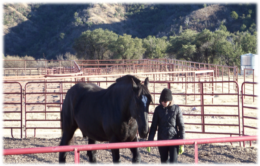
Here’s the encouraging part, especially for this tech-savvy audience: I can now present them with scientific data, and I mean real numbers, describing the nonverbal physiological effects that certain equine-facilitated activities have on people. And I can get quite specific. Due to the information gleaned from some initially surprising studies my colleagues and I completed over the past three years, I can even show how certain benefits can only be accessed and strengthened by working with full-sized horses (not dogs, and in some cases, not even mini horses).
Finally, I can connect these equine-facilitated activities with other published studies to show why certain skills exercised most efficiently with horses are beneficial, not only in learning to work more effectively with groups of humans, but in enhancing one’s own physical, mental and emotional health.
 Some of these techniques help soldiers, abuse survivors, and other people with post-traumatic stress learn how to consciously modulate their own nervous systems and think more clearly in settings that previously inspired panic. The same skills help spouses, parents, teachers, counselors, healthcare professionals, and animal rescue workers calm fearful or aggressive individuals, building trust and cooperation as a result.
Some of these techniques help soldiers, abuse survivors, and other people with post-traumatic stress learn how to consciously modulate their own nervous systems and think more clearly in settings that previously inspired panic. The same skills help spouses, parents, teachers, counselors, healthcare professionals, and animal rescue workers calm fearful or aggressive individuals, building trust and cooperation as a result.
If you want to turn an unproductive interpersonal trend around, what you communicate nonverbally can be more important than even most carefully chosen words. Considering that people with PTSD and anxiety disorders go to work, school, church and political events, leaders of all kinds need to know how to help people in tense situations override the flight, fight or freeze response. Fostering a centered, thoughtful, problem-solving state in others affects the bottom line. From employees, supervisors, and CEOs to nonprofit workers and volunteers, people who stir up trouble and/or obsessively feel the need to protect themselves waste incredible amounts of time and money. High drama and political games distract everyone from serving clients, fulfilling the organization’s mission, even completing the simplest tasks.
 Whipping large groups into states of fear and anger is a common ploy for heavy-handed leaders to gain a rudimentary sense of control. But this “technique” actually inhibits creative thought in others, eroding clarity, trust and compassion. People who know how to diffuse panic and aggression, on the other hand, inspire their followers to develop innovative solutions to technical and social challenges. This is a much more sophisticated leadership skill, one that requires nonverbal acuity and a certain amount of practice.
Whipping large groups into states of fear and anger is a common ploy for heavy-handed leaders to gain a rudimentary sense of control. But this “technique” actually inhibits creative thought in others, eroding clarity, trust and compassion. People who know how to diffuse panic and aggression, on the other hand, inspire their followers to develop innovative solutions to technical and social challenges. This is a much more sophisticated leadership skill, one that requires nonverbal acuity and a certain amount of practice.
In this effort, learning how to gain the respect and cooperation of a thousand-pound horse significantly elevates your ability to work with humans more effectively. The most powerful activities involve interacting with confident yet unrestrained horses who will simply move away from people who treat them like objects, try to manipulate them, or presume to intimidate them by stirring up fear to gain control. These same horses are happy to gently push disconnected, meek or overly accommodating people around, sometimes deftly controlling clients with a charisma that 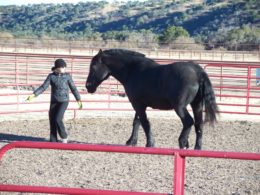 makes the human want to follow the horse’s wishes. Convincing an empowered herd member to follow your direction involves setting boundaries while simultaneously inviting connection and focusing on the goal at hand—with the right amount of energy and enthusiasm needed for each individual horse. Participants practice how to calm and center distracted herd members, and energize resistant horses, in part by harnessing physiological processes that are unconscious in most people. Working effectively with an animal who is constantly reading changes in your posture, breathing, heart rate, blood pressure, emotions, intent, and confidence (or lack thereof) significantly elevates your ability to influence a wide variety of humans in positive ways.
makes the human want to follow the horse’s wishes. Convincing an empowered herd member to follow your direction involves setting boundaries while simultaneously inviting connection and focusing on the goal at hand—with the right amount of energy and enthusiasm needed for each individual horse. Participants practice how to calm and center distracted herd members, and energize resistant horses, in part by harnessing physiological processes that are unconscious in most people. Working effectively with an animal who is constantly reading changes in your posture, breathing, heart rate, blood pressure, emotions, intent, and confidence (or lack thereof) significantly elevates your ability to influence a wide variety of humans in positive ways.
Fleet Footed Co-Conspirators
Ancestors of my equine colleagues, my not-so-secret weapons in this endeavor, empowered humans to expand their horizons long before recorded history. For over six thousand years, these strong, sensitive, intensely social beings gave humans a leg up in exploring new territory, for all kinds of lofty and nefarious reasons. In early times, when only a handful of cultures employed horses for defense or conquest, mounted warriors were virtually assured victory in any altercation. But as this earthy “technology” spread throughout the world, riders on both sides leveled the playing field. Horses could be employed by anyone, regardless of race, religion or intention, to free or enslave, inspire or, sadly, all-too-often, aspire to absolutely crush the competition.
These days, when horses are no longer required to work in our fields and carry us to war, they’re doing something I believe is more important: They’re helping us attain higher levels of health, wellbeing, self-mastery, and interpersonal acuity.
Most people are familiar with Equine-Facilitated Therapy. Active in the US since the 1950s, the field has been scientifically proven as an effective modality for persons with physical and developmental challenges. Equine-Facilitated Learning (EFL) is a more recent innovation, appearing on the 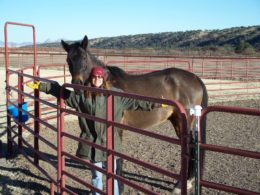 scene in the late 1990s. Reams of anecdotal evidence suggest that relatively simple activities on the ground with horses efficiently teach able-bodied, reasonably well-functioning people how to excel in personal and professional contexts. But the mystery of how this works has been difficult to study for one simple reason: Much of the learning happens at a nonverbal level. People often rave about an equine-facilitated leadership, team building, or personal development session that “changed their lives,” but they’re hard-pressed to explain what shifted. They only know they feel more balanced, inspired, and empowered.
scene in the late 1990s. Reams of anecdotal evidence suggest that relatively simple activities on the ground with horses efficiently teach able-bodied, reasonably well-functioning people how to excel in personal and professional contexts. But the mystery of how this works has been difficult to study for one simple reason: Much of the learning happens at a nonverbal level. People often rave about an equine-facilitated leadership, team building, or personal development session that “changed their lives,” but they’re hard-pressed to explain what shifted. They only know they feel more balanced, inspired, and empowered.
Since 2001, I’ve written five books on the subject of what horses have to teach humans, and I still feel like I’ve only scratched the surface of describing why horses are so effective at helping  people from all walks of life become better humans. The research for each book led to innovations in how I interact with both species, and how my colleagues and I create equine-facilitated activities for specific therapeutic or learning goals. To delve further below the surface, however, I knew we would need some more specific scientific data, and I’m pleased to report that over the last three years there’s been some real progress on this front. It’s now possible to gain a window into what’s happening at a physiological level when people and horses interact.
people from all walks of life become better humans. The research for each book led to innovations in how I interact with both species, and how my colleagues and I create equine-facilitated activities for specific therapeutic or learning goals. To delve further below the surface, however, I knew we would need some more specific scientific data, and I’m pleased to report that over the last three years there’s been some real progress on this front. It’s now possible to gain a window into what’s happening at a physiological level when people and horses interact.
In working with physiologist and mind-body scientist Ann Linda Baldwin, PhD, from the University of Arizona, I’ve seen first-hand that there are ways to measure the nonverbal effects of various equine-facilitated activities. In some cases, the results have been surprising, leading to longer-term studies that allow us to methodically tweak and improve the activities to produce the greatest possible benefits for physical, mental and emotional health, while also helping us to understand the “mechanics” of interactions that enhance relationship and leadership skills.
The research includes related studies Dr. Baldwin undertook with experienced equine-facilitated therapy and learning pioneers Barbara Rector, Ann Alden and Lisa Walters. This growing body of data has enhanced immeasurably the understanding I had previously gained from two decades of historical, cultural, anecdotal, and experiential evidence on the power and untapped potential of the horse-human bond.
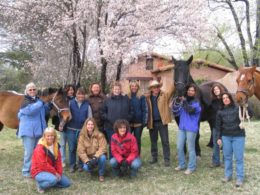 In 2017, I developed a modality called Sentient Communication®. This multi-disciplinary program teaches human development, leadership and health-enhancing skills through equine-facilitated experiential activities combined with modules on the research we’ve done. People gain insight into the physiological processes involved in optimal interpersonal interactions, while purposefully practicing these sometimes-counterintuitive skills. We also spend time learning how to take these techniques and principles back to the human world.
In 2017, I developed a modality called Sentient Communication®. This multi-disciplinary program teaches human development, leadership and health-enhancing skills through equine-facilitated experiential activities combined with modules on the research we’ve done. People gain insight into the physiological processes involved in optimal interpersonal interactions, while purposefully practicing these sometimes-counterintuitive skills. We also spend time learning how to take these techniques and principles back to the human world.
In 2018, an increasingly enthusiastic international response inspired my editor at New World Library to ask me to write a book on Sentient Communication. I know from past experience that this will be difficult and time-consuming. Finding ways to describe what is essentially beneath and beyond words is possible. We can use language to point to nonverbal feelings and transformational experiences through moving anecdotes and quotes from participants, combined with discussions of data that illuminate previously hidden physiological and psychological principles. But transmuting nonverbal nuances into linear language is more of an alchemical process than a straightforward methodical proposition, and it will likely take me several years to complete such a book.
In the meantime, workshops on Sentient Communication offer a much more immediate, inspiring, fun way to practice the skills, understand the mechanisms behind them, and more importantly, put these important innovations to use in human contexts.
How it Works
Sentient Communication training allows people to transform instinctual impulses and physiological processes into a language combining purposeful changes in breathing and heart rate, with a  finely tuned awareness of emotional cues, body posture shifts, energetic awareness, and intuitive insights. Among many other benefits, this translates into the ability to calm yourself and others, diffuse aggression, gain cooperation, and motivate groups to take productive action. These skills are more important now than ever before.
finely tuned awareness of emotional cues, body posture shifts, energetic awareness, and intuitive insights. Among many other benefits, this translates into the ability to calm yourself and others, diffuse aggression, gain cooperation, and motivate groups to take productive action. These skills are more important now than ever before.
Modern life encourages us to dissociate from feeling and withdraw from in-person exchanges while focusing our attention on a fast-paced, increasingly mechanized existence that overemphasizes the intellect in some circles, and encourages aggressive outbursts of emotion in other subcultures. These habits literally affect the bottom line in professional settings. According to the World Health Organization, stress costs American businesses up to $300 billion yearly, with 66% of employees reporting difficulty focusing at work due to stress.
Counselors across the U.S. note that the current political atmosphere is raising anxiety and stress in clients at alarming rates. This not only compromises physical health, it creates a sense of desperation that leads to unproductive, even dangerous behavior. According to FBI data released in November 2018, hate crimes rose for a third straight year, increasing 17 percent in 2017, the largest percentage increase in 10 years. Another poll taken shortly before the 2018 midterms showed that just over 20 percent of both Republicans and Democrats thought that members of the opposing  party were “evil.”
party were “evil.”
To heal the growing rifts in our culture, we must learn how to calm and focus ourselves and others in tense situations, manage fear and aggression in groups, respectfully communicate with those who hold different viewpoints and create innovative solutions to age-old problems. Sentient Communication skills help us move beyond stressful states of disconnection, while dramatically enhancing confidence, empathy, personal fulfillment, creative problem solving, physical health, and success in relationships.
The Grammar of Nonverbal Communication
The training method has much in common with how we acquire verbal and written language skills. Humans initially learn how to speak through daily experience in early childhood. Then, they go to “grammar school,” where they’re methodically taught to break sentences down into nouns, verbs, adverbs, adjectives, etc. This standard tutorial on the “mechanics” of language helps students develop greater facility and sophistication in expressing themselves through the spoken and written word.
 Sentient Communication (SC) training breaks down nonverbal forms of communication into key building blocks, some of which people have already learned experientially. For the vast majority of students, however, these processes remain unconscious, simply because our educational and social systems overemphasize verbal and symbolic language. SC training helps people become conscious of the basic nonverbal grammar they learned intuitively, so that they can use it purposefully, with increasing sophistication.
Sentient Communication (SC) training breaks down nonverbal forms of communication into key building blocks, some of which people have already learned experientially. For the vast majority of students, however, these processes remain unconscious, simply because our educational and social systems overemphasize verbal and symbolic language. SC training helps people become conscious of the basic nonverbal grammar they learned intuitively, so that they can use it purposefully, with increasing sophistication.
Some of the most impressive elements of Sentient Communication, however, involve breathing techniques, body postures, and behavioral responses that are counterintuitive in most people. It can feel a bit awkward at first to grasp this more advanced somatic language, similar to the way that learning to hold a pencil and write your name once felt awkward to your little kindergarten hands. However, these more powerful features of nonverbal language allow you to purposely alter heart rate, blood pressure and other physiological and psychological processes to support optimal levels of mental performance, physical and emotional health, leadership, and social engagement.
that are counterintuitive in most people. It can feel a bit awkward at first to grasp this more advanced somatic language, similar to the way that learning to hold a pencil and write your name once felt awkward to your little kindergarten hands. However, these more powerful features of nonverbal language allow you to purposely alter heart rate, blood pressure and other physiological and psychological processes to support optimal levels of mental performance, physical and emotional health, leadership, and social engagement.
“As a communications and change specialist, I am currently consulting on a two-country, four company merger in the finance and insurance sector,” says June Maine, who attended a September 2018 Sentient Communication training in Melbourne, Australia. “Following the weekend event, on Monday, I had been at work 7 minutes and was given the opportunity to put key techniques from the Sentient Communication workshop to the test in the workplace. Worked a treat (for me) as I dealt with someone who was quite argumentative.
“Cross-functional meetings are often quite oppositional as the project is complex and challenged with very tight timeframes. Having spent three days becoming very aware of my energy and how to change a tense human situation using Linda’s techniques with horses, I later tried these methods out in two meetings that are normally quite adversarial. The results were quite noticeable in the lack of escalations between normally argumentative individuals. As a further benefit, there was a significant reduction in the overall tension of the meetings. Clearly, this kind of improvement has positive results for all team members and the quality of outcomes. I was quite pleasantly stunned at the immediacy of the results and instant benefit of one weekend’s training.
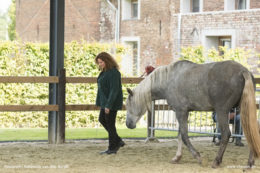 “Because horses are so skilled at non-verbal communication and very aware of their own boundaries, they are deeply experienced teachers who give clear feedback. I found working with horses using Sentient Communication techniques gave me a faster and sustained connection and awareness of myself compared to other meditation and breathing techniques I have learned. Working with these large sentient beings helps you get out of your head and into your body to be able to truly feel what is going on for you.
“Because horses are so skilled at non-verbal communication and very aware of their own boundaries, they are deeply experienced teachers who give clear feedback. I found working with horses using Sentient Communication techniques gave me a faster and sustained connection and awareness of myself compared to other meditation and breathing techniques I have learned. Working with these large sentient beings helps you get out of your head and into your body to be able to truly feel what is going on for you.
“Practicing these techniques with horses allowed me to pay close attention to my own reactions and feel subtle shifts. It is a truly unique learning environment which engages more of our senses, helping us learn powerful tools to achieve extraordinary results.”
Linda Kohanov is the best-selling author of five books, including The Tao of Equus, Riding between the Worlds, Way of the Horse, The Power of the Herd, and The Five Roles of a Master Herder.
Her next workshop on Sentient Communication takes place at her home base in Arizona, February 14 through 17. For more information on this workshop https://eponaquest.com/workshop/beyond-words-the-art-and-science-of-sentient-communication-2/.
Some sentient communication techniques and deeper intuitive skills will be taught in Linda’s upcoming Harnessing the Invisible: A Transformational Approach to Leadership, Innovation, and Authentic Community Building workshop that will take place May 18-21, 2019 in Amado, Arizona.
For more information on other workshops Linda offers, as well as a list of instructors worldwide trained in her methods, see www.eponaquest.com or www.masterherder.com.